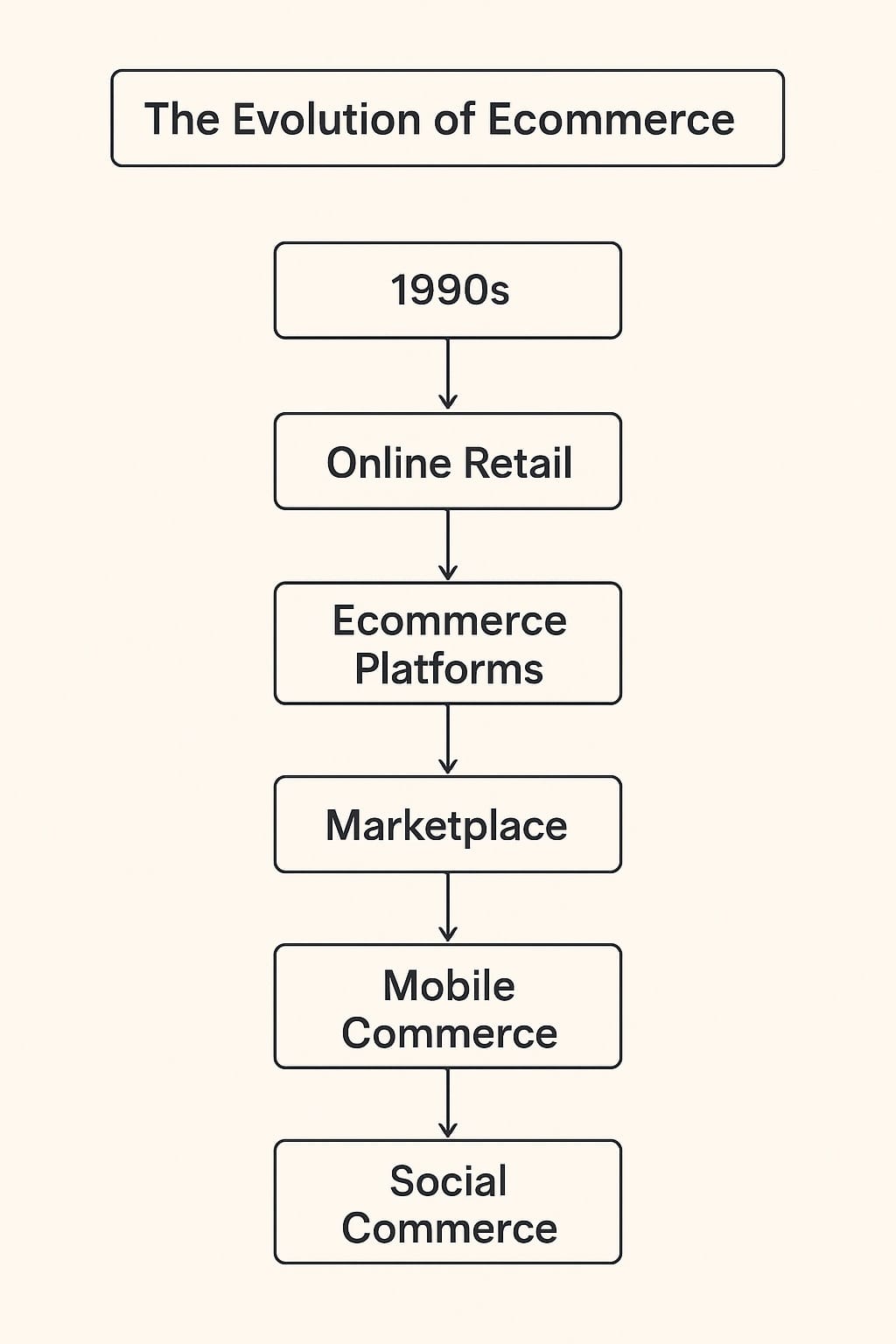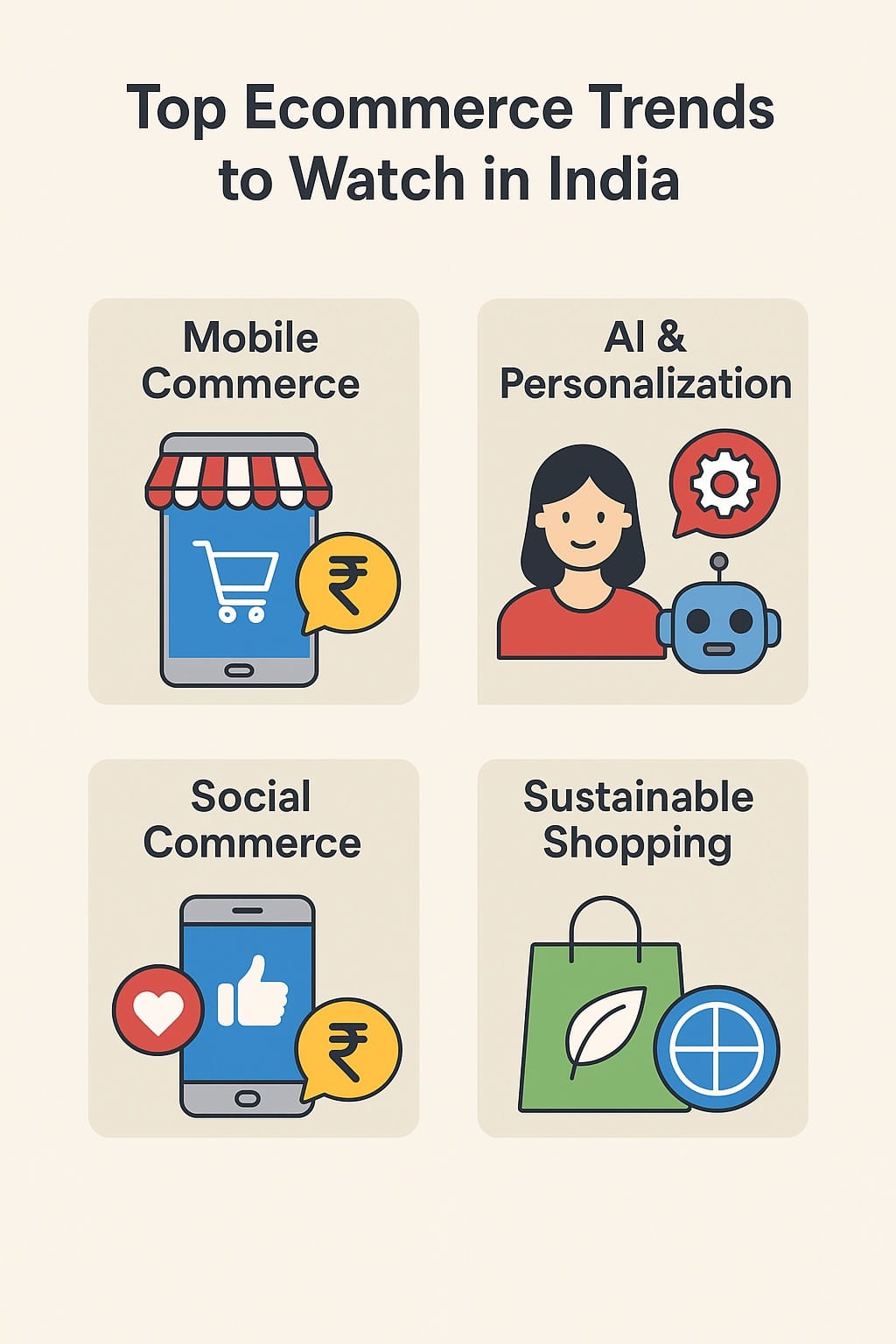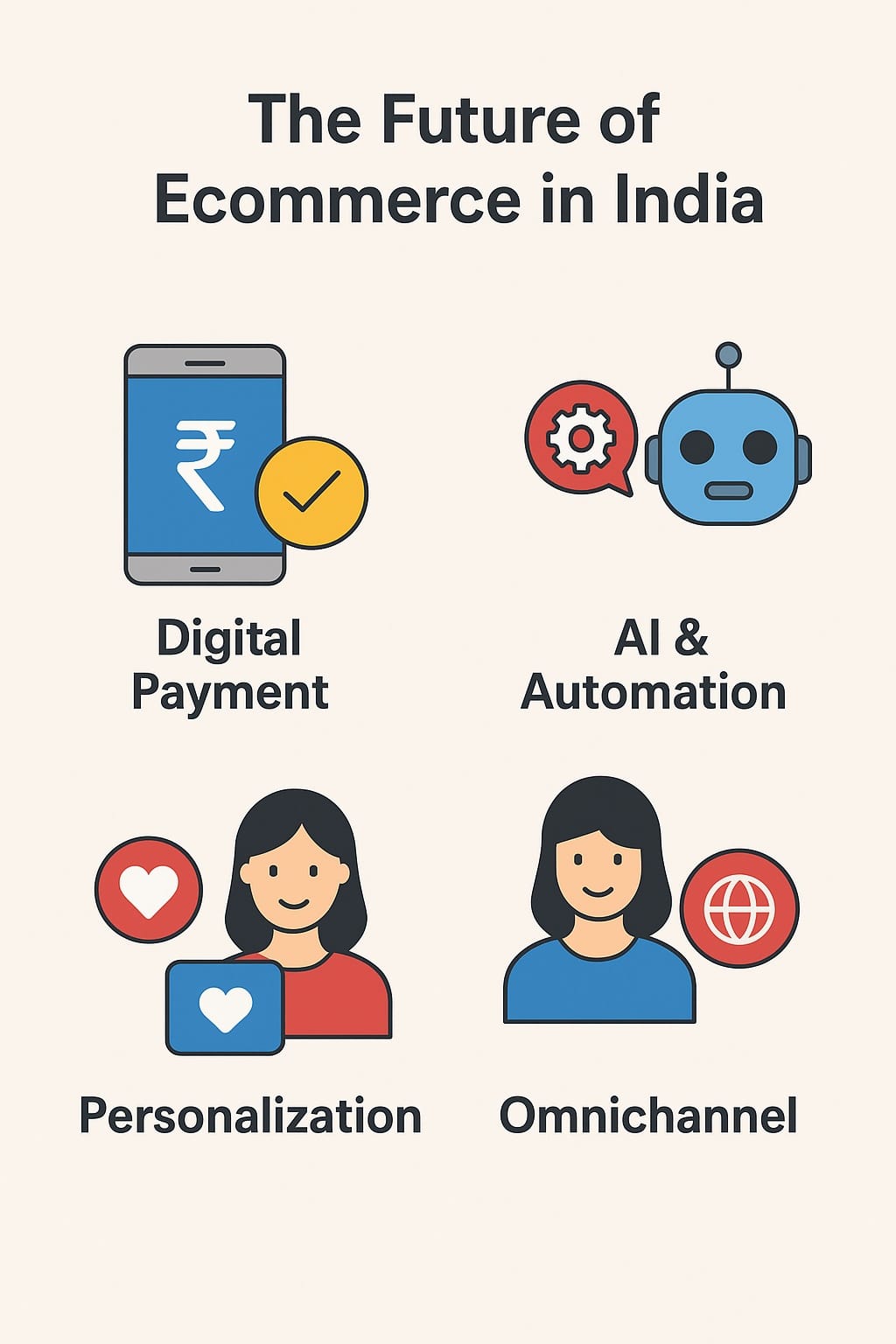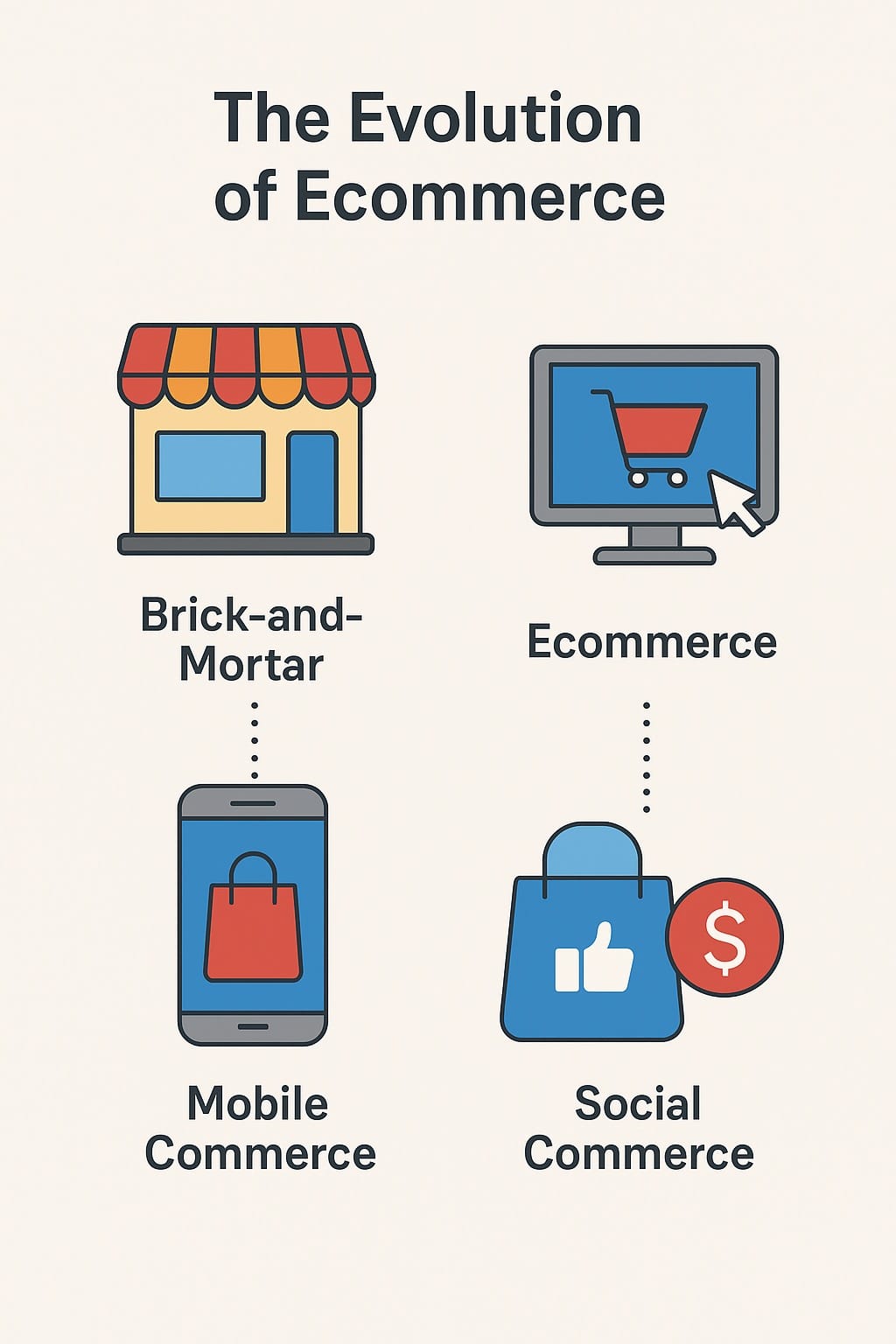Introduction to the Evolution of eCommerce
The landscape of shopping has undergone significant transformation with the advent of eCommerce. From humble beginnings as a novel concept to a dominant force in global retail, eCommerce has continuously evolved, reshaping how we purchase goods and services. As we delve into “The Evolution of eCommerce,” it’s essential to understand the driving factors behind this rapid growth and how they will influence future trends.
The journey of eCommerce began as a niche market for tech enthusiasts but has burgeoned into a multi-billion dollar industry. Today, eCommerce platforms offer unparalleled convenience, accessibility, and variety, making them an integral part of our daily lives. This evolution is not just about technological advancements but also about changing consumer behaviors and expectations.
Understanding the path eCommerce has taken is crucial for businesses and consumers alike. By analyzing past trends and current developments, we can better predict future shifts in the market. This knowledge empowers us to adapt to changes, ensuring that we remain competitive and relevant in a constantly shifting landscape.
Ecommerce in India has undergone a dramatic transformation over the past two decades—from a nascent digital experiment to a booming, tech-driven marketplace that now rivals global giants. Fueled by rising internet penetration, smartphone adoption, digital payments, and a young, tech-savvy population, India’s ecommerce sector is poised for exponential growth. With a projected market size of $350 billion by 2030 (up from $74.8 billion in 2023), the country is becoming one of the most dynamic digital commerce landscapes in the world.
This article explores the evolution of ecommerce in India, highlights the top trends shaping its present, and offers a forward-looking perspective on its future.
Historical Overview of eCommerce Development
eCommerce’s history is a fascinating tale of innovation and adaptation. It officially began in the late 20th century, with the first online transaction occurring in 1994 when a CD was sold through a website called NetMarket. This pivotal moment marked the beginning of a revolution in retail, paving the way for giants like Amazon and eBay to enter the scene.
The late 1990s and early 2000s witnessed the dot-com boom, where countless online businesses emerged, eager to capitalize on this new frontier. Although many failed, the survivors paved the way for future success by developing robust eCommerce models. These companies focused on building trust with consumers, enhancing security measures, and improving user experience.
As technology advanced, so did eCommerce capabilities. The proliferation of broadband internet, improved logistics, and the advent of mobile devices further accelerated growth. Today, eCommerce is not just confined to computers; smartphones and tablets have become the primary tools for online shopping, driving innovation and expanding market reach.

The Evolution of Ecommerce in India
- Early 2000s – The Pioneering Phase
Companies like Baazee.com (launched in 2000) and Rediff Shopping laid the groundwork. Transactions were limited due to low internet access, cash-on-delivery dependency, and consumer skepticism. - 2010–2014 – The Rise of Marketplaces
Flipkart (founded in 2007) and Amazon India (entered in 2013) revolutionized the space with deep discounts, logistics investments, and customer-centric policies. The “Great Indian Festival” and “Big Billion Day” sales became cultural phenomena. - 2015–2019 – Mobile-First & Digital Payments Boom
The Jio effect (2016) brought affordable 4G data, accelerating smartphone adoption. UPI (Unified Payments Interface) simplified digital transactions, while platforms like Paytm and PhonePe enabled seamless checkout experiences. - 2020–Present – Pandemic Acceleration & Hyperlocal Expansion
The COVID-19 pandemic acted as a catalyst, pushing millions of first-time users online. Categories like groceries, health, and home essentials saw explosive growth. Quick-commerce (q-commerce) and social commerce emerged as disruptive models.
Top eCommerce Trends to Watch in India
India, one of the fastest-growing eCommerce markets globally, presents a unique landscape filled with opportunities and challenges. As we explore the “Top eCommerce Trends to Watch in India,” it’s clear that several key factors are driving this growth. These trends offer insights into the future direction of online shopping in the region.
- Mobile Commerce Surge: With a significant portion of the population accessing the internet via smartphones, mobile commerce is poised for explosive growth. Companies are optimizing their platforms for mobile users, focusing on apps that provide seamless shopping experiences.
- Localized Shopping Experiences: Catering to diverse linguistic and cultural preferences, eCommerce platforms in India are tailoring their offerings to local tastes. This includes regional language support, localized marketing campaigns, and culturally relevant product selections.
- Integration of AI and Machine Learning: These technologies are enhancing personalization and efficiency in online shopping. From personalized recommendations to advanced customer service chatbots, AI is revolutionizing the way consumers interact with eCommerce platforms.
Further Ecommerce Trends to Watch in India (2024–2025)
- Social Commerce & Live Shopping
Platforms like Meesho, Instagram, and WhatsApp are enabling peer-to-peer selling and influencer-led live sales. With over 500 million WhatsApp users, conversational commerce is gaining traction—especially in Tier 2/3 cities. - Quick Commerce (Q-Commerce)
Startups like Blinkit (Zomato), Zepto, and Swiggy Instamart promise 10–30 minute deliveries for groceries and essentials. This model is reshaping urban consumer expectations and supply chain logistics. - AI-Powered Personalization
AI and machine learning are driving hyper-personalized recommendations, dynamic pricing, chatbots, and visual search. Companies are leveraging data to enhance user experience and boost conversion rates. - Voice & Vernacular Commerce
With 90% of new internet users coming from non-metro regions and preferring regional languages, platforms are investing in voice search and vernacular interfaces (e.g., Amazon’s support for Hindi, Tamil, Telugu). - Sustainability & Ethical Consumerism
Eco-conscious brands like The Better Home and Mamaearth are gaining popularity. Consumers increasingly demand transparency in sourcing, packaging, and carbon footprint—pushing platforms to adopt green logistics and circular economy models. - D2C (Direct-to-Consumer) Boom
Brands are bypassing traditional retail and marketplaces to build direct relationships via Shopify, WooCommerce, or proprietary apps. This trend empowers SMEs and fosters brand loyalty. - Rise of Tier 2/3 Cities & Bharat Users
Over 60% of new ecommerce users now come from smaller towns. Affordable data, localized content, and cash-on-delivery options are unlocking the “Bharat” market—making it the next growth frontier. - Regulatory Shifts & ONDC
The government-backed Open Network for Digital Commerce (ONDC) aims to democratize ecommerce by creating an open protocol that connects buyers, sellers, and logistics providers—reducing Big Tech dominance and fostering competition.
Understanding these trends is vital for any business looking to thrive in India’s burgeoning eCommerce market. By aligning strategies with these developments, companies can capitalize on the growing digital economy.

The Role of Technology in Shaping eCommerce
Technology is the backbone of eCommerce, driving innovation and shaping consumer experiences. From artificial intelligence to augmented reality, technological advancements are continuously redefining the boundaries of what’s possible in online retail.
Artificial Intelligence (AI) and Machine Learning (ML) have become indispensable tools for eCommerce platforms. They enable businesses to analyze consumer data, predict buying patterns, and provide personalized recommendations. This level of personalization not only enhances user experience but also boosts sales and customer loyalty.
Moreover, augmented reality (AR) and virtual reality (VR) are revolutionizing the way consumers interact with products online. These technologies allow shoppers to visualize products in real-world settings, bridging the gap between online and offline shopping experiences. As these technologies become more accessible, they will play a crucial role in the future of eCommerce.
Additionally, blockchain technology is emerging as a game-changer in eCommerce, offering enhanced security and transparency in transactions. By reducing fraud and building trust, blockchain can significantly improve consumer confidence in online shopping. As these technologies continue to evolve, they will shape the future of eCommerce in unprecedented ways.
The Future of eCommerce in India: Predictions and Insights
Looking ahead, the future of eCommerce in India is incredibly promising. The market is projected to grow exponentially, driven by increasing internet penetration, a burgeoning middle class, and a tech-savvy young population. These factors present a fertile ground for innovation and expansion in the eCommerce sector.
- Increased Penetration in Rural Areas: As internet access expands, rural areas in India are becoming new frontiers for eCommerce. Companies are investing in logistics and delivery infrastructure to tap into these untapped markets, offering a diverse range of products to a broader audience.
- Sustainable and Ethical Shopping: With growing awareness of environmental issues, consumers are increasingly seeking sustainable and ethically produced products. eCommerce platforms that prioritize eco-friendly practices and transparency in sourcing are likely to gain a competitive edge.
- Omnichannel Retailing: The integration of online and offline shopping experiences is set to become a defining feature of the Indian eCommerce landscape. Retailers are creating seamless transitions between digital and physical stores, providing consumers with a holistic shopping experience.
More on the Future of Ecommerce in India
- $350 Billion Market by 2030
Driven by 900+ million internet users, rising disposable incomes, and digital infrastructure, India will become the second-largest ecommerce market in Asia after China. - Convergence of Online & Offline (Phygital Retail)
Expect seamless integration between physical stores and digital platforms—think AR try-ons, scan-and-pay in malls, and inventory visibility across channels. - AI & Automation at Scale
From warehouse robotics to AI-driven customer service, automation will reduce costs and improve efficiency. Generative AI may soon power product descriptions, ad creatives, and even virtual shopping assistants. - Hyperlocal Ecosystems
Neighborhood kirana stores will digitize via platforms like JioMart and Udaan, becoming last-mile fulfillment hubs—blending tradition with tech. - Financial Inclusion via Embedded Finance
“Buy Now, Pay Later” (BNPL), microloans, and insurance will be embedded directly into shopping journeys—especially for underserved segments. - Metaverse & Immersive Shopping
While still nascent, virtual stores and 3D showrooms could redefine luxury and experiential retail in the next 5–7 years.
These predictions highlight the dynamic nature of the Indian eCommerce market. By staying ahead of these trends, businesses can position themselves for long-term success in this rapidly evolving industry.

Impact of Mobile Commerce on eCommerce Growth
Mobile commerce, or m-commerce, has emerged as a pivotal force in the growth of eCommerce. The widespread adoption of smartphones and mobile internet has transformed how consumers shop, making it imperative for businesses to prioritize mobile-friendly strategies.
One of the most significant impacts of m-commerce is the shift towards app-based shopping. Consumers prefer the convenience and speed of mobile apps, leading to increased investments in app development by eCommerce platforms. These apps offer personalized experiences, streamlined navigation, and exclusive deals, driving engagement and sales.
Moreover, mobile payment solutions have revolutionized the checkout process. With the rise of digital wallets and contactless payments, consumers can complete transactions with just a few taps on their smartphones. This convenience has reduced cart abandonment rates and increased conversion rates for mobile shoppers.
As mobile commerce continues to gain traction, businesses must adapt to this trend to remain competitive. By optimizing their platforms for mobile users and embracing innovative payment solutions, companies can harness the full potential of m-commerce to drive growth and success.
Importance of User Experience in Online Shopping
User experience (UX) is a critical factor in the success of any eCommerce platform. A seamless, intuitive, and engaging user experience not only attracts new customers but also fosters loyalty and repeat business. As online shopping becomes increasingly competitive, businesses must prioritize UX to stand out in the crowded market.
One key aspect of user experience is website speed and performance. Slow-loading pages can frustrate users and lead to high bounce rates. Therefore, optimizing website speed through efficient coding, image compression, and content delivery networks is essential to retain users and enhance their shopping experience.
Another crucial element is intuitive navigation. Consumers expect to find products quickly and effortlessly. By implementing clear categorization, effective search functions, and user-friendly interfaces, eCommerce platforms can simplify the shopping journey and improve user satisfaction.
Personalization also plays a pivotal role in enhancing UX. By leveraging data analytics and AI, businesses can offer personalized recommendations, tailor marketing campaigns, and create targeted promotions. This level of personalization not only boosts sales but also strengthens the emotional connection between the brand and the consumer.
The Rise of Social Commerce and Influencer Marketing
Social commerce and influencer marketing are reshaping the eCommerce landscape by merging the worlds of social media and online shopping. These strategies leverage the power of social networks and influential personalities to drive consumer engagement and boost sales.
Social commerce involves integrating eCommerce functionalities into social media platforms. Consumers can now discover, browse, and purchase products directly on platforms like Instagram, Facebook, and Pinterest. This seamless integration reduces friction in the shopping process and enhances user experience, making it a potent tool for businesses to reach their target audience.
Influencer marketing, on the other hand, capitalizes on the reach and credibility of social media influencers. By collaborating with influencers who resonate with their brand values and audience, businesses can promote products authentically and increase brand awareness. Influencers can create compelling content that showcases products in real-life scenarios, building trust and encouraging purchases.
As social commerce and influencer marketing continue to gain momentum, businesses must adapt their strategies to leverage these powerful tools. By aligning with the right influencers and optimizing their social media presence, companies can tap into new customer segments and drive growth.
SEO Strategies for eCommerce Success
Search Engine Optimization (SEO) is a vital component of eCommerce success. With millions of online stores competing for visibility, effective SEO strategies can significantly impact a business’s online presence and traffic. By optimizing their websites for search engines, businesses can improve their rankings and attract more potential customers.
One fundamental aspect of eCommerce SEO is keyword research. Identifying and targeting relevant keywords that align with consumer search intent is crucial for driving organic traffic. By incorporating these keywords into product descriptions, meta tags, and content, businesses can enhance their chances of appearing in search results.
Another important strategy is optimizing product pages. High-quality images, detailed descriptions, and customer reviews are essential elements of a well-optimized product page. These components not only improve user experience but also increase the likelihood of conversion.
Link building is another critical element of SEO. By acquiring backlinks from authoritative websites, eCommerce platforms can enhance their domain authority and improve search engine rankings. Collaborating with industry influencers, guest blogging, and participating in online communities are effective ways to build valuable backlinks.
How Maxsdigit eCommerce SEO Company in Mumbai, India Can Help
Navigating the complexities of eCommerce SEO can be challenging, which is where Maxsdigit eCommerce SEO Company in Mumbai, India comes into play. With expertise in crafting tailored SEO strategies, Maxsdigit can help businesses enhance their online visibility and drive targeted traffic to their eCommerce platforms.
Maxsdigit offers a range of services, including comprehensive keyword research, on-page optimization, and technical SEO audits. Their team of experts works closely with clients to understand their unique needs and develop customized strategies that align with their business goals.
In addition to traditional SEO services, Maxsdigit specializes in local SEO, helping businesses tap into local markets and reach nearby customers. By optimizing for local search terms and managing online reviews, Maxsdigit ensures that businesses stand out in their respective regions.
Choosing Maxsdigit as your SEO partner means gaining access to cutting-edge tools and industry insights. Their commitment to staying abreast of the latest SEO trends and best practices ensures that your eCommerce platform remains competitive in the ever-evolving digital landscape.
Challenges Ahead
- Logistics in remote areas
- Data privacy and cybersecurity
- Regulatory uncertainty (e.g., FDI norms, ONDC adoption)
- Profitability pressures amid intense competition
Conclusion: Embracing Change in the eCommerce Landscape
As we reflect on “The Evolution of eCommerce,” it’s evident that the industry is in a constant state of flux. From technological advancements to shifting consumer preferences, the eCommerce landscape is continually evolving, presenting both challenges and opportunities.
Embracing these changes is essential for businesses aiming to thrive in the digital age. By staying informed about emerging trends, leveraging innovative technologies, and prioritizing customer experience, companies can position themselves for long-term success.
The evolution of ecommerce in India is a story of relentless innovation and adaptation. From its humble beginnings as an online bookstore, it has grown into a complex, multi-faceted ecosystem that is reshaping the Indian economy. The trends of today—quick commerce, D2C, and AI—are laying the foundation for a future where shopping is more personal, immediate, and integrated into our daily lives than ever before. For businesses and consumers alike, the most exciting chapters of this story are yet to be written.
In conclusion, the future of eCommerce is bright, filled with potential for growth and innovation. As we navigate this dynamic landscape, it’s crucial to remain adaptable and open to new possibilities. Whether you’re a business owner or a consumer, embracing change will ensure that you remain at the forefront of the eCommerce revolution.

Ready to take your eCommerce business to the next level? Partner with Maxsdigit eCommerce SEO Company in Mumbai, India, and unlock the full potential of your online platform. Contact us today to learn more about how we can help you succeed in the ever-evolving digital marketplace
Maxsdigit, Mumbai, India – Ecommerce SEO Services